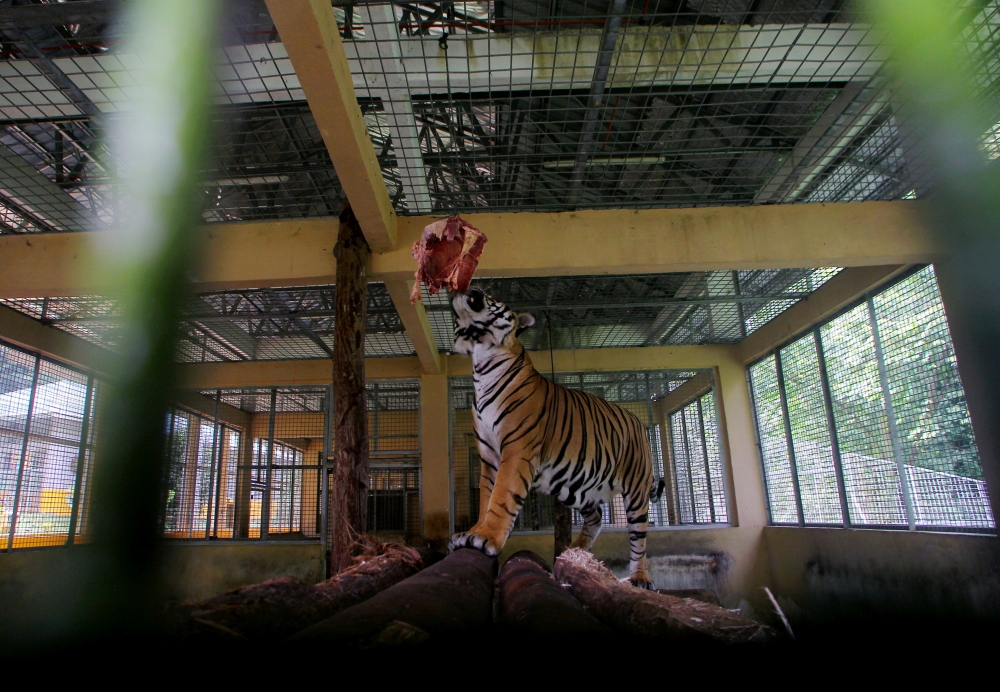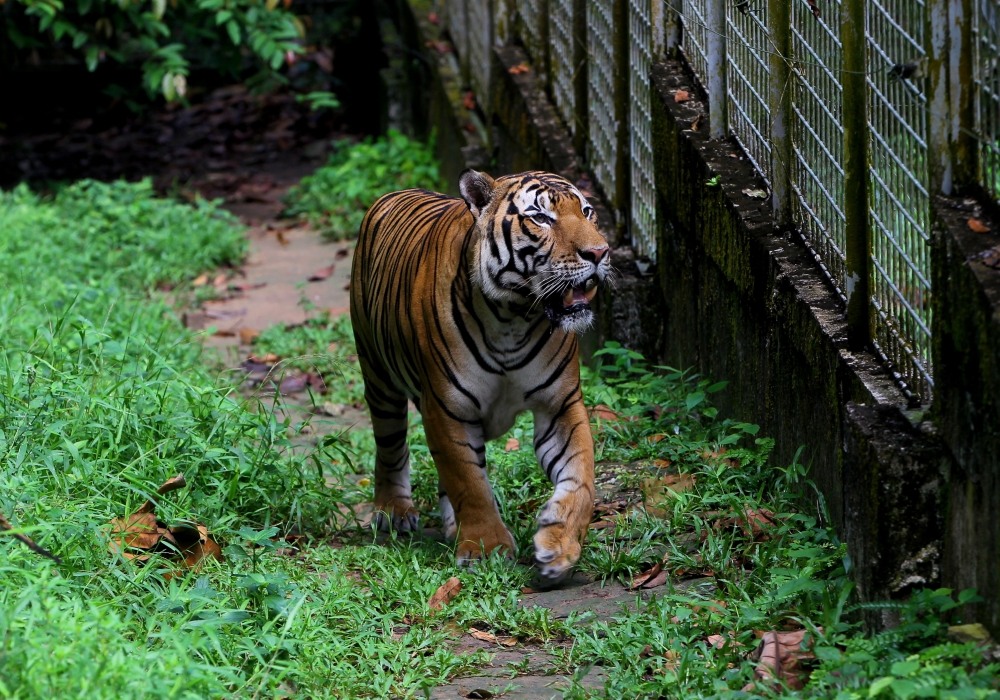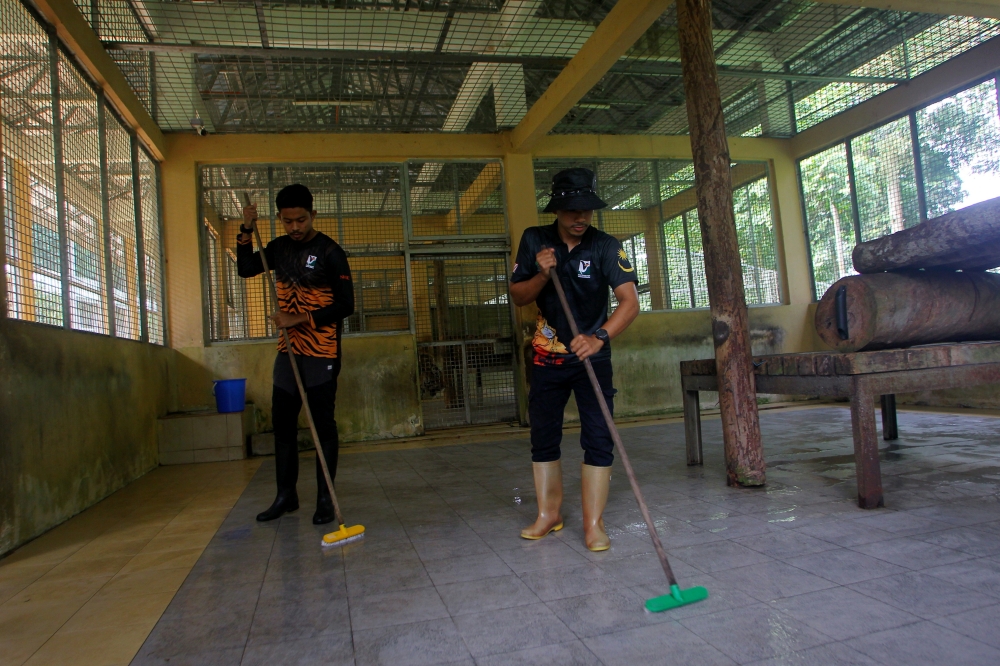SUNGKAI (Perak), Aug 1 — Clutching hatchets, several men chop up slabs of meat, making sure it is cut in the right size — just the way their “wards” would want them. The meat pieces are then scooped up into a red bin and ready to be fed to the prized denizens of the National Wildlife Rescue Centre (NWRC) here, namely the tigers.
Currently, the sanctuary has 12 Malayan tigers that were either rescued from the jungle after sustaining injuries caused by traps or handed over by other zoos in the country.
The Malayan tiger, the scientific name of which is Panthera tigris malayensis or Panthera tigris jacksoni, is totally protected under the Wildlife Conservation Act 2010 and classified as Critically Endangered under the International Union for Conservation of Nature (IUCN) Red List for Threatened Species.
Land clearing activities and exploitation of forests have resulted in Malaysia’s wild tiger population dwindling to an estimated 150.
According to tiger keeper Rahmat Rohani @ Abdul Ghani, 51, who has been working at NWRC for 10 years, although the tigers there are fed and cared for, they are also “rewilded”, that is, trained to hunt for food so that they can survive in the wild when they are released into their original habitat someday.
He said the big cats are fed about 100 kilogrammes of various types of meat a day, with the quantity of meat consumed by each tiger equivalent to five per cent of its body weight.
“They eat once a day at 3pm because that’s when they are most active but it doesn’t mean they will all eat exactly at 3pm,” Rahmat told Bernama, adding that the animals are fed beef, live and processed chicken and frozen meat.
Incidentally, the tigers are fed only six days a week and made to fast once a week to ensure their intestines and digestive system remain healthy.
During the day, the tigers are left to roam in a forest-like park next to their night enclosure and “we (seven tiger keepers at NWRC) only enter (the night enclosure) to place their food there when all the tigers are (safely) outside”.

Recreate jungle environment
NWRC, which comes under the purview of the Department of Wildlife and National Parks Peninsular Malaysia and was set up in accordance with the provisions under the International Trade in Endangered Species Act 2008 (Act 686), serves as a centre housing endangered wildlife species rescued after sustaining injuries or from smugglers. Its functions are based on the 3R concept, that is, rescue, rehabilitate and release.
Rahmat, who was a wildlife assistant and later tiger keeper at the Melaka Zoo before being transferred to NWRC in 2014, said the 12 tigers there are aged between six and 20 and they have even been given names. The females are Cindai, Nikki, Zanah, Mek Santung, Chemon and Stacy, while the males are Yeop Tapah, Sungkai, Johny, Jeli, Jay and Dido.
On the rewilding process to prepare the ferocious cats to reenter their natural habitat, Rahmat said the tiger keepers use their own creativity to expose the animals to nature and revive their hunting instincts.
“One of the ways we do this is by placing their food in various parts of their night enclosure, instead of putting it all in one place. For example, we would hang some meat from the ceiling or hide it behind a banana tree or various types of leaves... this is aimed at stimulating the animals’ sense of smell and prompting them to search for food based on its scent,” he explained.
Interestingly, he and his colleagues have managed to use all kinds of foliage such as banana leaves and oil palm fronds to recreate a jungle-like environment inside the night enclosure, which has cement walls and floor.
Even the park measuring 30 metres by 42 metres outside the enclosure where the tigers are free to roam between 8.30am and 3pm, partly mimics their natural habitat.
Sometimes, a few goats are released into the “jungle” to enable the tigers to get used to hunting for their own food.
“This is a part of the rewilding process to enable them to survive in their original habitat,” Rahmat said.

Cannot be complacent
Even though Rahmat has worked with tigers for a decade and is familiar with their habits and movements, he cannot afford to be complacent even for a second while on duty.
This is because tigers can be unpredictable, requiring their keepers to be on their guard at all times no matter how trivial a task may seem.
Rahmat’s cautiousness has so far prevented him from getting hurt or finding himself in a precarious situation. This is, indeed, an achievement for him as a tiger keeper.
“Not all tigers have the same disposition. That’s why we (tiger keepers) have to learn to recognise the habits (and attitudes) of these animals and handle them accordingly.
“I can say among the challenges of caring for a tiger is that we can’t predict what it’ll do even if we have been taking care of it for a long time,” he said.
Despite the danger lurking around, Rahmat is committed to taking care of some of the world’s most deadly predators as he wants to do his part to conserve the Malayan tiger.
“At our centre, the tigers are taught to hunt for food but we also provide food for them and this helps to ensure the survival of these increasingly endangered creatures,” he said, adding that he enjoys observing their movements and also likes the sound of their roar.

Successful
Hairul Anwar Nordin, 26, who is also a tiger keeper at NWRC, said he chose this career as he loves to take up new challenges especially those related to the management of wildlife in captivity.
“I feel not everyone can take on the responsibility of managing tigers in captivity. I do have fear, yes, but my desire to learn something new is driving me to pluck up the courage,” he said.
For him, the most challenging part of his work is ensuring the tigers are rewilded and can survive on their own after they are reintroduced to the jungle.
“If we are able to do so, then it will be considered a success and an unforgettable experience,” said Hairul Anwar, who joined NWRC three years ago.
He and his fellow tiger keepers start work at 8 am when they make their rounds to ensure the tigers are all safe and sound in their night enclosure.
“If a tiger is sick, we will give them medicine at around 6 or 7pm by stuffing it into their meat. Some will have to be sedated in order for us to administer other treatments,” he added.
Meanwhile, NWRC head Ishak Muhamad said besides tigers, the centre also has in its care other wildlife species such as sun bears, tapir and panthers as well as primates like siamang and ungka.
He said when it first opened, 20 tigers from Melaka Zoo were handed over to the centre for medical treatment before they were transferred to the Malayan Tiger Conservation Centre (MTCC) in Lanchang, Pahang, where they were exposed to crucial survival skills prior to their release into the wild.
He added that NWRC has also been given the responsibility to breed tigers, with the goal to increase their numbers to 400.
“(If our breeding programme is successful) the offspring of the rescued male and female tigers will be sent to MTCC where they will be rewilded to enable them to survive in their natural habitat later on. The rescued male and female tigers, meanwhile, will remain at NWRC for the rest of their lives,” he said.
Tigers in captivity can live up to 26 years compared to 20 years for those living in the wild. — Bernama






















